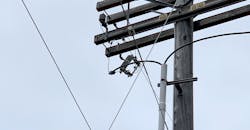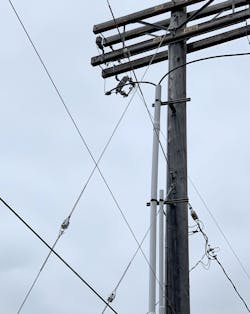The Case of the Telecom Technician Electrocution
Employees of communications companies (who as a general rule are not high-voltage qualified) find themselves working in proximity to overhead power lines daily. They are trained to stay a safe and appropriate distance from the overhead power lines, and they use personal protective equipment (PPE) appropriate for the tasks of their employment. While most go home at the day’s end, I get to review the cases that end with unanticipated injury or death from accidental contact with high-voltage lines.
The Scene
The decedent was an employee of a telecommunications company. The day of his death started like most others. He was given a service ticket and tasked with resolving a typically mundane problem as reported by a customer of the cable company. He arrived on-site — no doubt noticing that the telecommunications wires were located on a shared-service power pole. He certainly would have known to keep an appropriate distance from the 7.2kV uninsulated distribution line conductors at the top of the pole. Both training and experience would have dictated that he remained within his safe work zone and be cognizant of the dangerous environment above his head. However, it was a time of year when the foliage was dense with the telecommunication lines and low-voltage service lines disappearing into the greenery. The power lines at the top of the pole were similarly obscured by the dense foliage on the trees.
Guy wires are a key design component in the proper support of utility distribution poles.
As he had done almost every day of his career, he surveyed the environment, put on his PPE, took his fiberglass ladder and leaned it up against the pole, positioning himself so he could access a telecommunications service drop. As required, he was wearing a harness, which he used appropriately to prevent an accidental fall. He was noted to be wearing work gloves and rubber soled shoes.
The Accident
Shortly after the decedent started his work, the local power company received several calls reporting an outage in the area. Two linemen were dispatched to track down the source of the outage, repair the issue and restore power to the affected customers. Upon arriving on scene, they found a substation circuit breaker had tripped. They then started walking the line looking for the cause.
The power company employees came upon the decedent, still attached to the power pole by his harness, with his feet still on the ladder and his body slumped over. He was non-responsive when the linemen tried to get his attention. They observed that his left hand was in contact with a guy wire above the location of the “Johnny ball” (egg-shaped porcelain strain) insulator. The linemen immediately called for assistance and followed procedure to rescue the decedent from the power pole. He was brought to the ground and was found to be beyond resuscitation.
The Investigation
An investigation revealed that one phase of the 3-phase distribution line atop the pole had become disconnected from the power pole and dropped down on top of the guy wire in such a way as to energize the guy wire to 7.2kV right above the porcelain strain insulator.
The testimony of the linemen, which established the decedent’s position when located, was confirmed by the autopsy. Deep carbonized burns were found on the palm of the decedent’s left hand. He had extensive burning to his sweatshirt and left forearm. Burns and extensive charring were also found on the decedent’s right hand, and his beard was noted to be singed. The autopsy noted the cause of death as “high-voltage electrocution.”
A lawsuit was brought by the estate of the decedent against the power company, among others.
I was retained by the plaintiff’s counsel and asked to quantify the electric shock, do a burn pattern analysis, and opine as to how long, if at all, the decedent would have experienced cognitive pain prior to his death.
The site investigation and a study of the burn pattern told a very clear story of how the incident had occurred. The decedent, while working in what he had reason to believe was a safe work zone had his right hand on (or in proximity to) a grounded component of the telecommunications system when his left hand came into contact with the guy wire, which was energized due to the conductor that had broken free of its support at the top of the pole. There was no indication by way of the burn pattern to suggest any lower body involvement as would be consistent with his isolation on the fiberglass ladder.
The singing of his beard was consistent with proximity to an arc flash, but not consistent with head involved electrical entry or exit points. Deep carbonized burning to his hands was consistent with arc entry/exit points as well as a shock of significant enough duration to cause localized resistive heating and burning. Burns on his forearm were consistent with flame burns from ignited clothing and flash burns from an electric arc.
The Analysis
Ultimately, I concluded that the decedent had suffered a non-head-involved hand-to-hand electric shock at a distribution voltage level of enough duration to cause the breaker to trip and result in the power outage. The magnitude of the current (assuming typical body resistance) would have been several amperes.
When confronted with the question of cognition and pain, I concluded that since the current flow did not involve the decedent’s brain, his brain was functioning and as oxygenated at the instant after the shock started as it would have been immediately before, thus leading to a high level of cognition at the time that the shock started with cognition rapidly decreasing as brain oxygenation decreased over the course of the shock due to a cessation of oxygenated blood flow to the brain. The duration from onset of the shock until either electrically induced ventricular fibrillation (or cardiac standstill) caused a loss of oxygenated blood to the brain is unknown but would typically be some number of seconds.
The decedent would have probably had a period of consciousness during which time he would have experienced painful muscle contraction, painful stimulation of sensors in his skin, pain from the electrical arc, resistive burning of his tissues, and pain from flash and flame burns. The pathway of the current would have crossed his chest, leading me to at least consider that there might have been a period when he was cognizant and suffering from electrically induced respiratory arrest, leading to a sensation that he was suffocating and reinforcing any sensations that he was in a dire situation from which escape was impossible.
When asked to quantify the duration of cognition and pain, I determined that it would be the duration from the start of the shock until the heart stopped functioning as a pump of oxygenated blood plus the duration during that the oxygen remaining in the brain is depleted, leading to a loss of consciousness. There is a body of literature on this topic that suggests that the duration can be anywhere from several seconds to not much longer than 15 seconds.
If one takes the time to count off 15 seconds and consider all of the thoughts that can cross someone’s mind in that duration, it is easy to understand that the last 15 seconds of the decedent’s life would have been nothing short of horrific.
As with most cases, this case settled for a confidential and undisclosed amount.
Lessons Learned
While I have done many cases in which telecom workers are accidentally electrocuted, this case is perhaps sadder than most because the decedent made no mistakes to contribute to his own death. He wore the proper PPE, followed procedure, and stayed in the safe work zone for his task and training. He was unaware the energized power line conductor above his head had broken free of its support and energized the guy wire that ultimately delivered the current that caused his death.
The defense might argue that a more thorough visual inspection prior to starting work might have found the problem. Similarly, the plaintiff might argue that proper routine inspection of the power pole might have revealed impending failure before the energized conductor fell on the guy wire.
What stands out most in this case is that the guy wire insulator was at a level where the decedent could stay in his work zone and still easily contact the guy wire segment above the insulator. While each side can argue the negligence of the other, there is no question that had the insulator been placed higher on the guy wire, beyond the reach of the decedent, no shock would have occurred.
At the end of the day, it comes down to the little details. Power companies have a duty to inspect and maintain the safety of their facilities. On an unknown number of inspections over the life of this pole, the incorrect placement of the insulator in the guy wire was never observed and corrected. Per the testimony of other experts, this insulator was placed in the wrong position, which was an NESC violation due to the fact that it did not provide adequate and safe clearance with the lower lines. The result was the death of a telecom worker doing his job as he would have continued to do but for a fatal flaw that existed.
In the 30 years and more than 400 electrical incident cases I have reviewed, some types of accidents tend to repeat themselves more than others. Unfortunately, this is one such example.
Dr. Morse is a professor of electrical engineering at the University of San Diego. He has reviewed hundreds of electrical injury cases. His research has focused on studying the effects of electricity on the human body. More information on electrical injury can be found at www.electricalinjury.com.

